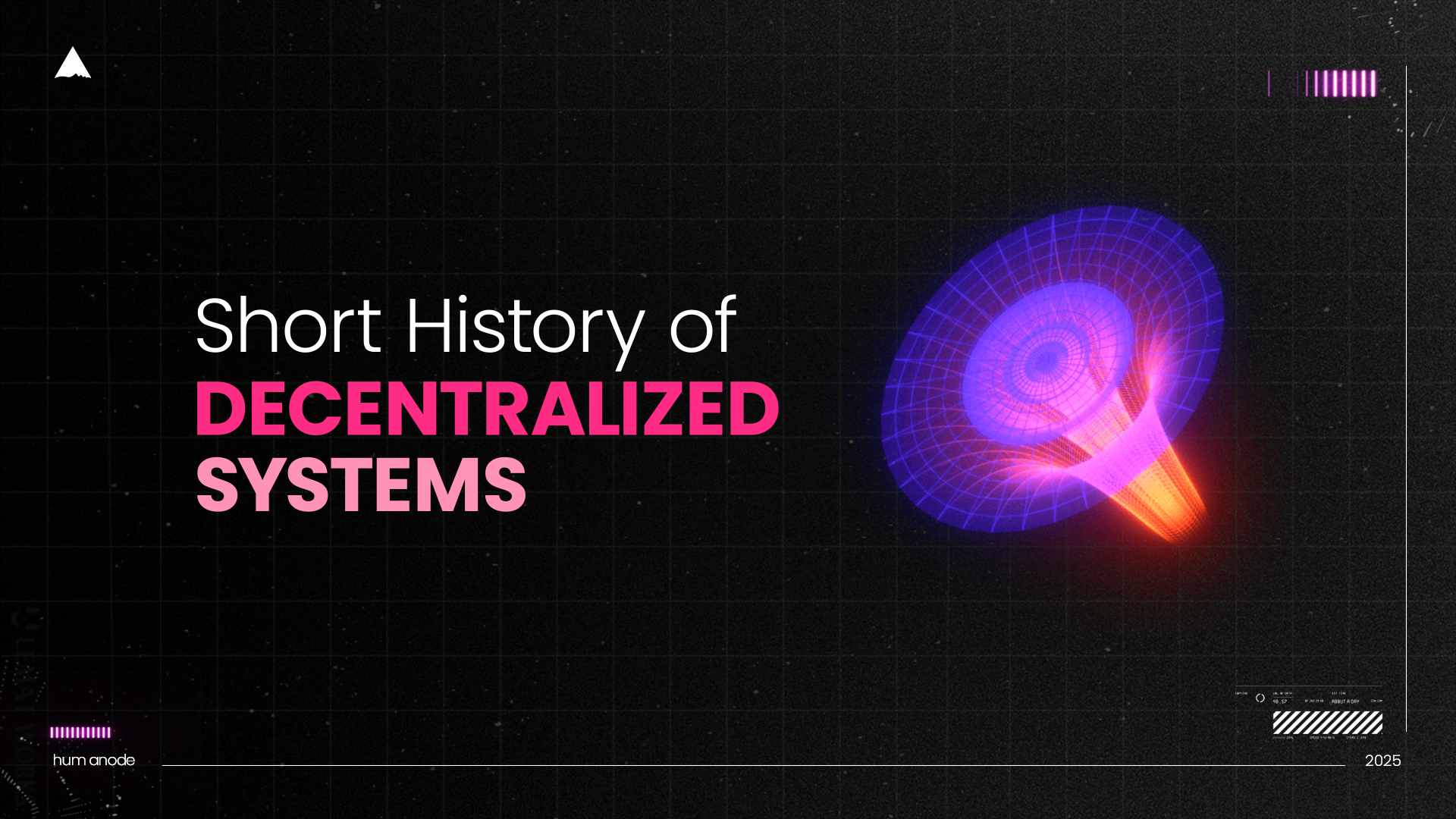A Short History of Decentralized Systems - Part 1

When you think of decentralization, the first thing that probably comes to your mind is blockchain. But the truth is, decentralization isn't something as new as blockchain; it's been with us since humans first gathered around campfires.
Yes, decentralization actually started way before we built the first computers, back when tribes and small communities operated without any single leader. What they do is give everyone a voice in an egalitarian system. Decisions about migration, food distribution, or resolving conflicts were made by consensus, not orders from a chief. Elders or respected community members might guide discussions, but ultimately, everyone got a say. This early form of peer-based, egalitarian governance laid the groundwork for what we'd later call democracy.
Think about ancient Greece, especially Athens, where citizens directly voted on major decisions. Or consider indigenous communities around the world that relied on councils and clans instead of monarchs. These egalitarian societies proved that decentralization wasn't just possible, it was powerful.
Fast forward to the mid-20th century, and decentralization starts to shape technology. In 1964, Paul Baran introduced groundbreaking ideas about network structures:
- Centralized: One node connects everything. Simple, but if it fails, the whole network fails.
- Decentralized: Several nodes act as mini-centers. More resilient, but still vulnerable.
- Distributed: Every node connects with multiple others, no single point of failure. Maximum resilience.
Inspired by Baran's work, engineers created ARPANET in 1969, the ancestor of today's Internet. ARPANET used packet-switching, allowing data to route around broken or blocked paths automatically. It was fundamentally decentralized by design.
By the '70s and '80s, other systems were built on this idea:
- USENET (1979) allowed messages to move across multiple servers, with no central control.
- FidoNet (early 1980s) connected individual bulletin boards peer-to-peer, letting information flow freely.
These early networks weren’t just technical experiments; they proved the practical strength and resilience of decentralized systems, showing that communities could connect, communicate, and thrive without a central gatekeeper.
So, grab a seat by our digital campfire as we explore how decentralization evolved into a defining force behind today's Web3, reshaping how we share information, organize communities, conduct finance, and distribute power.
Peer-to-Peer Networks: The 1990s–2000s Revolution
In the the late 1990s and early 2000s, when the internet was young, the potential was huge, and decentralization was about to take a massive leap forward. Peer-to-peer (P2P) networks emerged, shifting power from central servers to users at the edges. Let’s look into the big milestones of this P2P explosion.
1999 – Napster Changes Everything
It all kicked off when a teenager named Shawn Fanning launched Napster in June 1999. If you are a boomer or millennial, you can recall the craze. Suddenly, users could directly share MP3 files, no need for record stores or big labels. Napster exploded because it was fast, easy, and revolutionary.
But there was a catch: Napster wasn’t fully decentralized. It relied on central servers to index songs and connect users. This became its downfall, once courts ruled it was facilitating piracy, Napster's servers shut down, and the network collapsed. But Napster showed the world what P2P could do.
2000 – Beginning of True Gnutella and Freenet
Napster’s collapse sparked innovation. Developers wanted networks without a central point that could be shut down. Enter Gnutella and Freenet:
- Gnutella let users search for files without central servers. Every user's computer acted as both client and server, sharing and passing search queries through a decentralized network.
- Freenet took it further by creating a fully decentralized, anonymous network. Data was spread across nodes, making censorship and shutdown attempts nearly impossible.
These networks showed true decentralization in action, no single entity could control or kill them.
2001 – BitTorrent Raises the Bar
In 2001, developer Bram Cohen launched BitTorrent, redefining file sharing. BitTorrent breaks files into pieces distributed across multiple users simultaneously. The more popular a file was, the faster and more efficient downloads became. Initially reliant on trackers (servers coordinating peers), it later evolved with trackerless, fully decentralized technology (Distributed Hash Tables, or DHTs). BitTorrent provedthat decentralization wasn't just resilient, it could scale massively.
Early 2000s – Distributed Computing
P2P wasn't just about music or movies. It extended into computing. Projects like SETI@home and Folding@home allowed everyday users to contribute idle computing power to massive research projects. SETI@home created a virtual supercomputer from millions of home PCs, scanning data for extraterrestrial signals. This showed decentralization could tackle complex, global-scale problems, even if task distribution remained centralized.
2002 – Tor
In 2002, Tor entered the scene, revolutionizing online anonymity. Using volunteer-run nodes and layered encryption, Tor enabled secure, private browsing without any central servers tracking user activities. It showed how decentralization could empower privacy, becoming essential for activists, journalists, and everyday users needing secure communication.
Mid-2000s – P2P Goes Mainstream
Even voice communication became decentralized. Skype, launched in 2003, used a hybrid model, centralized user directories but decentralized call traffic, routed peer-to-peer. This meant reliable, efficient communication without massive central servers.
Other platforms like Kazaa and eMule continued evolving decentralized file sharing, using innovations like supernodes and distributed hash tables (DHTs) to optimize networks further.
The P2P revolution proved decentralization wasn't just a neat idea, it was transformative:
- Resilience: No single points of failure.
- Empowerment: Users controlled resources, becoming both consumers and providers.
- Innovation: Concepts like DHTs, swarming, peer reputations, and supernodes became foundations for future decentralized systems.
Sure, there were challenges, search efficiency, malware threats, and security concerns, but the message was clear: decentralized networks could thrive without central control, changing how we share information and laying the groundwork for blockchain's arrival.
The Blockchain Revolution: (2008–Present)
Let’s rewind to 2008. The world is in crisis. Financial institutions are unraveling. People are realizing that trusting centralized banks and governments might not be the safest way to manage value.
And then, quietly, anonymously, a whitepaper lands in a cryptography mailing list.
“Bitcoin: A Peer-to-Peer Electronic Cash System.”
And with that, the first decentralized digital currency is born.
Bitcoin’s creator, Satoshi Nakamoto, introduced a revolutionary idea: a global monetary network that no one controls. No governments. No banks. No company in the middle.
Instead, trust would emerge from open source code and economic incentives.
The core mechanism that made it all work? Proof of Work.
In PoW:
- Thousands of nodes (miners) race to solve a cryptographic puzzle.
- The winner gets to add the next block of transactions to the blockchain and earns newly minted bitcoin.
- The rest of the network verifies the block.
This process creates decentralized consensus, a way for the entire network to agree on what happened, in what order, and who owns what, without relying on a central party.
It’s slow. It’s energy-intensive. But it’s permissionless and secure. And in January 2009, it went live with the mining of Bitcoin’s genesis block.
Bitcoin showed the world that trust could be automated. That rules could be enforced by math. And that money, for the first time, could live natively on the internet.
2011–2014: Forks, Failures, and the Consensus Arms Race
Soon after, experiments begin. Developers fork the original codebase. Some try new hashing algorithms. Others introduce tweaks to block time or rewards. And this experimentation raised a new question:
Can we build alternative forms of consensus that are cheaper, faster, and more energy-efficient than PoW?
One system replaces energy expenditure with financial collateral, birthing Proof-of-Stake (PoS).
PoS offered an answer:
- Instead of burning electricity, validators “stake” coins as collateral.
- The more you stake, the more likely you are to be selected to create the next block.
PoS was more efficient, but it came with new problems. Validators now earned influence based on how much they staked. Wealth started to centralize. The rich could validate more, earn more, and dominate governance. More wallets didn’t mean more people, just more ways for a single actor to amplify their voice. The Sybil problem hadn’t gone away. It had just changed form.
Consensus was no longer just about who had the most computing power, but who could be trusted, and how that trust was measured is still debateable.
2015: Ethereum and the Programmable Web
Then came Ethereum, a platform that didn’t just track balances but ran logic. Smart contracts let developers encode agreements directly onto the blockchain, rules without rulers.
Ethereum began with PoW but had bigger ambitions: more transactions, more use cases, and a broader developer base. Eventually, it transitioned to Proof-of-Stake in 2022.
The mechanics changed:
- Validators are selected based on how much ETH they stake.
- Blocks are proposed and attested by a network of validators.
- Finality is achieved through economic penalties, cheaters lose their stake.
It’s greener. It’s faster. But PoS still concentrates power among large stakers and exchanges. And it doesn’t solve Sybil resistance; anyone with enough funds can spin up as many validators as they want.
Ethereum unlocked new types of applications. But the problems of consensus, fairness, and identity weren’t going anywhere.
The Rise of DeFi
With smart contracts came DeFi, a new financial system built entirely in code:
- Lending protocols.
- Decentralized exchanges.
- Stablecoins.
No banks. No borders. No permission needed.
But once again, decentralization exposed its weak spot: Sybil resistance.
Airdrops got farmed by bots. Governance votes were dominated by whales. Yield farming got exploited by users with dozens, or hundreds, of wallets.
How do you prevent one person from pretending to be many?
This is the classic Sybil attack. And it became the Achilles’ heel of many DeFi platforms.
PoS didn’t solve it. Wallets didn’t solve it. DeFi needed a new way to ensure fairness, without going back to KYC and surveillance. And it’s still the same for major DeFi apps today.
DAOs: From Democracy to Tokenocracy
Around the same time as DeFi was emerging, a concern over how we make the rules for running blockchain became a point of interest. This gave birth to DAOs, Decentralized Autonomous Organizations, which were supposed to be the governance layer of Web3.
DAOs, or Decentralized Autonomous Organizations, promised a new form of coordination, governance without middlemen, where decisions are made by communities on-chain.
But most DAOs rely on token-weighted voting: one token equals one vote. In theory, it’s democratic. In practice, it’s plutocratic. Large holders dominate. Sybils flourish. Whales split their holdings across wallets. Bots swarm to governance votes.
Some DAOs tried quadratic voting. Others explored reputation systems. But without a reliable way to ensure one person equals one identity, they kept hitting the same wall. There is no digital equivalent of a raised human hand.
True democratic governance needs a way to prove personhood.
IPFS and the Web’s Missing Layer
Meanwhile, the InterPlanetary File System (IPFS), introduced in 2015, addressed another piece of the decentralization puzzle: storage.
Rather than store files on centralized servers, IPFS used a peer-to-peer network. Files were addressed by their content hash, not their location. Retrieval was handled by a Distributed Hash Table (DHT), which pointed users to whichever peer had the content.
It solved persistence and censorship resistance for decentralized apps. IPFS was an essential layer, but not the full stack.
So What’s the Pattern?
Across every layer of Web3, money, logic, governance, identity, and storage, the same challenges keep surfacing:
- Consensus mechanisms trade off between security, efficiency, and fairness.
- PoW is energy-heavy and prone to mining centralization.
- PoS is capital-driven and vulnerable to wealth concentration.
- Token governance favors the rich.
- Sybil attacks remain the silent killer of fairness in every system.
So, what do we need next?
A system that doesn’t just verify keys or balances, but verifies humans. A consensus model that doesn’t rely on energy or capital, but on biometric uniqueness.
A new way to measure trust, not by what you have, but by who you are.
That’s what Humanode set out to build.
And that’s what we’ll explore in part 2.

